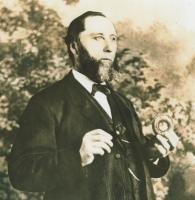
Captain Hansen Gregory
Some friends of mine think that I am crazy because I seem to find nautical connections in just about everything. (Other friends think I am crazy for other reasons.) Take for example, the modern donut. What about a donut could possibly have anything to do with sailors, ships or the sea? In fact, the development of the modern donut is usually attributed to Hansen Crockett Gregory, 1832-1921, a ship’s captain from Rockport, Maine. Here is the “hole” story.
The first donuts in America did not have holes. They are believed to have been introduced to the continent by the Dutch who fried dough in oil. Washington Irving was the first to mention doughnuts in “The History of New York” in 1807. We wrote, “[I]t was always sure to boast of an enormous dish of balls of sweetened dough, fried in hog’s fat, and called dough-nuts, or oly koeks: a delicious kind of cake, at present known scarce to this city, except in genuine Dutch families.”
These doughnuts or oily-cakes were lumps of fried dough. Because the dough in the center didn’t fully cook the center was often filled with nuts or fruit.
Capt. Hansen Gregory, as a 16-year-old crewman on a lime-trading schooner in 1847, would change the world of donuts forever when he invented the donut hole. Years later he told his story to a reporter from the Washington Post:
Now in them days we used to cut the doughnuts into diamond shapes, and also into long strips, bent in half, and then twisted. I don’t think we called them doughnuts then–they was just ‘fried cakes’ and ‘twisters.’ “Well, sir, they used to fry all right around the edges, but when you had the edges done the insides was all raw dough. And the twisters used to sop up all the grease just where they bent, and they were tough on the digestion.
Gregory asked himself if a space inside the dough would solve the difficulty – and then he got the great inspiration:
I took the cover off the ship’s tin pepper box, and—I cut into the middle of that doughnut the first hole ever seen by mortal eyes!
He returned to Camden, Maine, where he taught his mother the trick. She sent several plates to Rockland, Maine, where they were a smashing success. Donuts were never the same afterward. The hole increased the surface area, exposure to the hot oil, and therefore eliminated the uncooked center.
More colorful versions of Gregory’s invention of the doughnut hole include Gregory impaling a doughnut on the ship’s steering wheel so that he could use both hands to steer, or that the idea for the shape being delivered to him in a dream by angels. Whatever did or did not happen, the modern donut was born, the inspiration of a Maine sea captain.
On the 100th anniversary of Gregory’s invention, a plaque was erected at his birth site in Rockland, Maine, commemorating the good captain and his donut hole.

The ship’s cook would knead the dough bare chested and roll the dough on his naked chest. Some sailors were observing this and one said it was disgusting, the way he kneaded the dough. The other said, “you think that’s bad, you should see the way he makes donuts!”
It was my understanding that the hole served another purpose.
When frying the old donuts without holes, the outer edges would cook, but the center remained raw. The hole in the donut was born.
They are easy to turn and retrieve from a hot pot of oil.
Pingback: What Dessert Are You? A Factorialist Personality Test - Factorialist